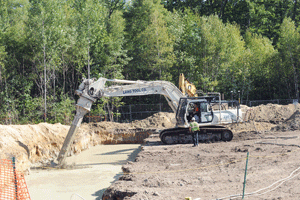CONWAY — The chemical treatment of the remaining pollution at the former Kearsarge Metallurgical Corp. Superfund site began Monday. The effort is expected to continue for the next few weeks.
The site, next to Pequawket Pond, is where KMC made stainless-steel valves from 1964 to 1982. The KMC made stainless-steel castings for the nuclear power industry. Over that time, “waste acids, chlorinated solvents, caustics and flammable liquids” spilled onto the ground, contaminating soil as well as groundwater, according to documents from the U.S. Environmental Protection Agency.
The EPA and state Department of Environmental Services spent decades cleaning up and monitoring the site with a pump and treat system. By 2012, state and local officials were under the impression that the site was almost clean and that any remaining chemicals would stay trapped in the ground or dissipate naturally.
In the spring of last year, the town sold the land to a heating/towing company. The area in question is owned by Hurteau Enterprises, but that land isn’t being used by the company because it’s forested wetland.
At the selectmen’s meeting of May 19, state Environmental Services engineer Andrew Hoffman, along with Fred Symmef of Weston Solutions Inc., said that the remaining chemicals were actually migrating through the soil. In 2013 and 2014, state officials began to become concerned about the chemical migration and then began developing plans to treat it, according to Hoffman, who called this procedure a “polishing step.” In May, they said the area needing to be cleared comprises roughly 4,000 square feet.
The plan, Hoffman explained on Tuesday, is to use hydrogen peroxide solution and an iron catalyst that chemically burns the contaminants and dissipates them within a day. An estimated 44,000 gallons worth of chemicals will be injected.
“There’s no smoke or fire, but it is off-gassing,” said Hoffman. “You can see it bubbling up. It’s really boiling mud.”
The off-gases from the process are carbon dioxide, oxygen and methane.
“It’s not polluting at all,” said Hoffman.
Originally, crews were going to inject sodium persulfate, but that would have taken much longer to dissipate.
An excavator with special attachments mixes the soil and injects the chemicals into a large L-shaped pit of boiling mud. The crews know exactly how deep in the “L” to dig and how much chemical to apply in each spot because of GPS mapping technology.
The depth of mixing starts at 7 feet and goes down to 15 feet. The excavator digs six different rows based on where the pollution is in the ground.
The EPA will pay for 90 percent of the cost, which Hoffman said was about $500,000, and the state will cover the rest. Hoffman said the cost is about $500,000. Over a half-dozen people are working on the project. The state’s consultant is Weston Solutions, which is headquartered in Pennsylvania. A Michigan company called Lang Tool is doing the work with some technical assistance from a New Jersey-based company called Isotech.
In 2003, a “big dig” effort took place to clean up the contaminants. At that time, they removed over 5,000 tons of impacted material. But a “finger” of pollution was left unaddressed until now.
“That finger of residual contamination continues to bleed off and causes groundwater quality violations of drinking water quality standards,” said Hoffman, adding that treatment work will go on for a few weeks. Seeding and land restoration efforts should be done by the middle of October. He expressed optimism that the project could be completed early due to good weather and favorable soils.
There will be no cost to Conway or the property owner. After three to 10 years, the site will be delisted from being a Superfund site, Hoffman added.
The crews are doing water tests twice a day to ensure there is no impact on Pequawket Pond, said Hoffman, noting that contingency plans are in place if a problem does arise.
